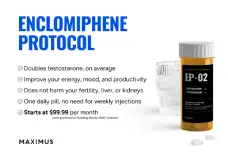madman
Super Moderator
* IGF-1 measured by LC-MS before and after clomiphene therapy.

Abstract
Context
The selective estrogen receptor modulator clomiphene stimulates pituitary-derived gonadotropins to generate sex steroids including estrogen. Estrogen activates SOCS-3 which can inhibit growth hormone-directed JAK/STAT signaling to reduce serum IGF-1 levels.
Objective
We sought to examine the effects of clomiphene therapy on IGF-1 levels in non-acromegalic male patients treated with clomiphene for underlying hypogonadism.
Design
We identified 20 male hypogonadal subjects treated with clomiphene citrate for at least three months.
Setting
These patients were treated in an ambulatory, academic, tertiary medical center.
Patients
The 20 male patients ranged from 27-76 years of age and hypogonadism was due to several etiologies, including prolactinomas, clinically non-functioning pituitary tumors, rathke’s cleft cysts, colloid cysts or idiopathic causes.
Intervention
Clomiphene citrate 50 mg three days per week was administered for a minimum of three months.
Main Outcome measure(s)
IGF-1 measured by LC-MS before and after clomiphene therapy.
Results
15 of 20 (75%) of hypogonadal men treated with clomiphene exhibited a decrease in median (IQR) serum IGF-1 levels of -0.60 (-1.2 - 0.0) (p<0.01). Two of the 20 patients (10%) exhibited a decrease in IGF-1 > 2 standard deviations below their age- and sex-matched mean value.
Conclusions
Clomiphene therapy can result in a significant reduction in serum IGF-1 levels in some treated hypogonadal men. Given that the decrease in IGF-1 can be >2 SD in some patients and potentially clinically significant, we recommend interval monitoring of serum IGF-1 levels and symptoms of growth hormone deficiency in hypogonadal patients treated with clomiphene citrate.
Abstract
Context
The selective estrogen receptor modulator clomiphene stimulates pituitary-derived gonadotropins to generate sex steroids including estrogen. Estrogen activates SOCS-3 which can inhibit growth hormone-directed JAK/STAT signaling to reduce serum IGF-1 levels.
Objective
We sought to examine the effects of clomiphene therapy on IGF-1 levels in non-acromegalic male patients treated with clomiphene for underlying hypogonadism.
Design
We identified 20 male hypogonadal subjects treated with clomiphene citrate for at least three months.
Setting
These patients were treated in an ambulatory, academic, tertiary medical center.
Patients
The 20 male patients ranged from 27-76 years of age and hypogonadism was due to several etiologies, including prolactinomas, clinically non-functioning pituitary tumors, rathke’s cleft cysts, colloid cysts or idiopathic causes.
Intervention
Clomiphene citrate 50 mg three days per week was administered for a minimum of three months.
Main Outcome measure(s)
IGF-1 measured by LC-MS before and after clomiphene therapy.
Results
15 of 20 (75%) of hypogonadal men treated with clomiphene exhibited a decrease in median (IQR) serum IGF-1 levels of -0.60 (-1.2 - 0.0) (p<0.01). Two of the 20 patients (10%) exhibited a decrease in IGF-1 > 2 standard deviations below their age- and sex-matched mean value.
Conclusions
Clomiphene therapy can result in a significant reduction in serum IGF-1 levels in some treated hypogonadal men. Given that the decrease in IGF-1 can be >2 SD in some patients and potentially clinically significant, we recommend interval monitoring of serum IGF-1 levels and symptoms of growth hormone deficiency in hypogonadal patients treated with clomiphene citrate.














